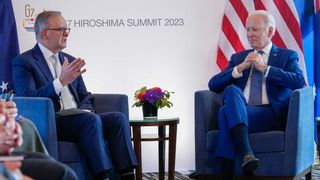While not the high-profile event on the shores of Sydney Harbour that Prime Minister Albanese was undoubtedly hoping for, the images of him and President Biden congratulating one another for ‘the Australia-United States Climate, Critical Minerals, and Clean Energy Transformation Compact’ on the sidelines of the G7 should be encouraging for onlookers on both sides of the Pacific. Echoing Climate Change Minister Chris Bowen, who in a speech last year called climate change a “centerpiece of our alliance,” the two leaders proclaimed that climate and clean energy are now the “Third Pillar” of an “Alliance for our Times,” joining the economy and defence as the all-important third leg of the stool.
Promising to fill out the details by the end of the year, the Compact provides broad guidance on the contours of Australia-US climate and clean energy cooperation. This cooperation looks to focus almost exclusively on electric vehicle supply chains — especially the critical minerals needed in battery production — as well as green hydrogen production. For the most part, the Compact is a partnership to share information and coordinate standards in support of its ambitious goals.
Within the context of Sullivan’s speech, the Australia-US Climate Compact can be seen as a reflection of the Biden administration’s goal to “pursue modern trade agreements” as a means of meeting key climate and economic goals. According to Sullivan, trade agreements will no longer focus on “trade liberalization as an end in itself” but should be a means of coordinating on industrial policies and bolstering supply chain resilience.
Assuming the respective bureaucracies can adequately fill in these details, the agreement is a major milestone. Broadly speaking, it is the latest example of an emerging Biden Doctrine that is rapidly shifting the tools and objectives of economic and climate statecraft. With respect to climate change, the Compact has the potential to address some of the key vulnerabilities in the clean energy transition for two countries that share a remarkably similar political economy environment around the issue.
A new “Washington Consensus”
It is no coincidence that the Clean Energy Transformation Compact, as well as a number of related initiatives like the G7 Clean Energy Economy Action Plan, were all announced less than a month since Biden’s National Security Advisor gave what may go down as the most significant foreign policy speech of this administration, and almost certainly of the post-Trump era. Describing what he labels as the “new Washington Consensus,” Jake Sullivan tied together the loose threads of domestic industrial policy, ‘de-risking’ the relationship with China, taking action on climate and clean energy, and investing in the Global South.
The most striking aspect of Sullivan’s remarks, and of the administration’s approach in general, is their emphasis on a domestic industrial policy designed to bolster the US industrial base, counter China, address climate change, and mitigate widening inequalities. The administration was firmly focused on the domestic pieces of this agenda while it still had Congressional majorities in 2021–22, but with no chance of further legislative action this term, it is now busily propagating its “Modern American Industrial Strategy” on the global stage.
Within the context of Sullivan’s speech, the Australia-US Climate Compact can be seen as a reflection of the Biden administration’s goal to “pursue modern trade agreements” as a means of meeting key climate and economic goals. According to Sullivan, trade agreements will no longer focus on “trade liberalization as an end in itself” but should be a means of coordinating on industrial policies and bolstering supply chain resilience.
This new approach was already apparent a year ago when President Biden launched the Indo-Pacific Economic Framework for Prosperity (IPEF), an unusually wide-ranging multilateral economic discussion that included a similar emphasis on supply chain resilience, investment, and clean energy rather than the erosion of trade barriers. IPEF is perhaps a cautionary tale, however, with little to show for the effort a year later. The administration has yet to add real substance to the initiative while many of its signatories remain wary of an agreement that offers few tangible economic benefits in exchange for agreement on a wide range of sensitive political objectives.
Opportunities for Canberra and Washington
For Canberra, this push for “modern” trade agreements is likely concerning for a government that remains among the world’s foremost defenders of the ‘international rules-based order’ and its traditional emphasis on free trade. However, Australia stands to gain enormously from further investments in global supply chain resilience, particularly those in the EV supply chain. Australia has successfully negotiated free trade agreements with dozens of countries and can only expect diminishing marginal returns on further liberalisation, whereas it will need all the help it can get to develop the necessary financing, workforce and technological know-how to compete in the higher value-added industries that could accompany further investments in clean energy supply chains.
Meanwhile, between ongoing geopolitical tensions with China and the regulatory hurdles of approving new mines domestically, the United States faces severe bottlenecks in sourcing the critical minerals necessary to its transition. Australia’s vast abundance of many of these minerals will be a vital lifeline for the United States as it attempts to ‘de-risk’ the relationship with China while dramatically expanding its domestic battery and electric vehicle manufacturing industry.
In this vein, one of the few specific announcements from the two leaders this week was a remarkable plan to ask Congress to add Australia as a “domestic source,” under Title III of its Defense Production Act. This would allow US funds to flow directly to Australian suppliers of critical minerals and technologies — an extraordinary step towards integrating the two markets and a pointed effort by the Biden administration to lure Australian minerals away from China. The Compact also includes an emphasis on the role of export credit agencies as one means of re-investing in this capacity, as does the formation of the Quad Investors Network, which promises to facilitate access to capital and technology partnerships throughout the region. Such steps could open up significant export opportunities for Australia and, as Climate Energy Finance director Tim Buckley puts it, “massively boost our reindustrialisation potential.”
This arrangement, where US capital and industrial expertise are exported to Australia in exchange for critical minerals and commodities, is an important step in the two countries’ decarbonisation trajectories because it addresses two of the key challenges in their respective political economies. Arguably, Australia’s single greatest vulnerability in decarbonisation is the industrial challenge of building up a clean energy-based economy to match the fossil fuel exports that have maintained growth for a generation. Australia’s industrial base has been hollowed out for forty years and US capital and technological expertise will be critical to developing the materials processing facilities and green hydrogen production plants that could become significant sources of economic growth going forward.
Meanwhile, between ongoing geopolitical tensions with China and the regulatory hurdles of approving new mines domestically, the United States faces severe bottlenecks in sourcing the critical minerals necessary to its transition. Australia’s vast abundance of many of these minerals will be a vital lifeline for the United States as it attempts to ‘de-risk’ the relationship with China while dramatically expanding its domestic battery and electric vehicle manufacturing industry.
Aligning Australian and American industrial policy agendas
All told, the Australia-United States Climate, Critical Minerals, and Clean Energy Transformation Compact reflects the transformational shift in climate and clean energy policy underway in both countries. Both Biden and Albanese have hit the ground running with their respective climate agendas and share a distinctive ‘green industrial policy’ approach. Between the Inflation Reduction Act, the bipartisan infrastructure law, and the CHIPS and Science Act, the Biden administration is on track to spend an average of AUD$120 billion annually over the next ten years on climate. Meanwhile, the Albanese government has pushed ahead with its Powering Australia Plan, which, though modest in comparison to the US approach, mirrors many of its fundamental principles. These principles include a preference for ‘carrots’ over ‘sticks,’ the powerful role of public financing institutions in de-risking novel technologies, and a political pragmatism that avoids a damaging backlash from powerful fossil fuel interests.
Where the Biden administration is increasingly at loggerheads with Europe on these principles, the Labor government is working hard to align itself with the US approach. This is a win-win strategy. Australia’s fiscally conservative politics and small-currency status limit its fiscal capacity to compete with the United States, leaving it little choice but to hitch itself to the US juggernaut. In multilateral settings, the Biden administration’s willingness to continue Trump’s legacy of flouting global institutions like the World Trade Organization means it’s all the more important that Australia cement its value in ‘mini-lateral’ groupings like AUKUS, the Quad, and G20. Finally, Australia truly does have the opportunity to become a “renewable energy superpower,” supplying the world with clean, cheap energy, critical minerals, while channeling capital and technology into the Indo-Pacific, one of the world’s most vulnerable regions to the effects of climate change.




.jpg?rect=0,80,3000,1989&fp-x=0.5&fp-y=0.44772296905517583&w=320&h=212&fit=crop&crop=focalpoint&auto=format)

